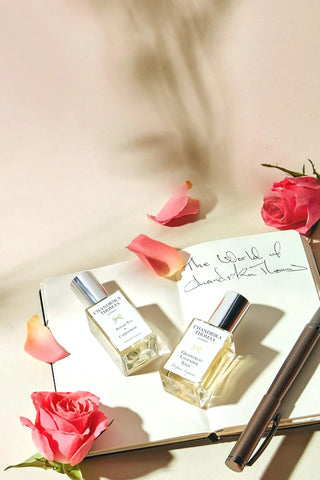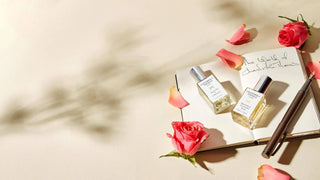Across history and cultures, scent has played a quiet but essential role in how people endure the colder months. Long before central heating or electric light, fragrance was used to warm spaces, lift spirits, and create a sense of community when days grew dark and cold.
In ancient temples, resins such as myrrh and frankincense were burned not only for their spiritual significance but also for their ability to fill the air with a rich, warming aroma. In medieval Europe, pomanders made of clove-studded oranges and spice blends were carried in the winter to offer comfort and ward off illness. In the Middle East, oud and incense still form part of evening rituals when temperatures drop, creating a sense of warmth and belonging.
This tradition continues today, though in more refined forms: a spiced perfume worn on the skin, a diffuser glowing gently in the corner of a room, or a candle whose fragrance transforms an otherwise grey evening. Scent, in every era, has been one of the ways we create comfort, stability, and even joy during the long winter season.

Why Fragrance Feels Different in Winter
Cold weather changes the way perfume behaves. In warm conditions, fragrance molecules rise and disperse quickly, making lighter notes like citrus, green florals, and fresh herbs sparkle. However, in winter, with cooler, denser air, those same notes often vanish before we can fully enjoy them. This is why a perfume that feels radiant in July may seem fleeting in December.
Heavier notes, however, woods, resins, spices, and gourmands, thrive in cooler air. They release more slowly, staying close to the skin and unfolding gradually. These fragrances seem to “cling” in a way lighter ones cannot, creating the sense of warmth and intimacy we instinctively seek in darker months.
Beyond science, there is psychology. Studies in aromachology suggest that scents such as vanilla, amber, and sandalwood can reduce stress and bring feelings of comfort, while spice notes like clove and cinnamon stimulate the senses, brightening even the dullest winter day. In this way, fragrance serves both a practical and an emotional role, adjusting with the season just as our wardrobes, diets, and daily rituals do.

The Notes That Bring Comfort in Colder Days
When it comes to fragrance, certain ingredients seem almost designed for winter. They carry a depth and warmth that lighter, summery scents cannot match, creating an invisible layer of comfort when the air outside feels sharp.
-
Amber and Resins – Rich and enveloping, notes like amber, myrrh, and olibanum (frankincense) have been used for centuries in winter rituals. They feel grounding and almost meditative, adding a sense of calm.
-
Woods and Oud – Dark woods, sandalwood, and oud offer structure and depth. They lend stability and warmth, anchoring a fragrance much like a solid oak table anchors a room.
-
Vanilla, Tonka, and Gourmand Accords – Sweet, creamy notes bring to mind kitchens filled with baking and festive treats. These scents are nostalgic and soothing, evoking a sense of home.
-
Spices – Cinnamon, clove, nutmeg, and cardamom add brightness and sparkle, echoing the comforting aromas of mulled wine or spiced tea.
These notes form what might be thought of as a “winter palette” for perfumery. They not only last better in cooler weather but also align beautifully with the emotions and rituals of the season, offering both physical presence and emotional reassurance.


Cultural Traditions of Winter Fragrance
Fragrance has always played a role in how communities around the world navigate the colder months. Long before perfume was bottled and sold, people turned to natural aromatics to bring comfort, warmth, and even protection during the darker season.
-
The Middle East: In cooler evenings, the slow burn of oud chips or bakhoor fills homes with richness and depth. The smoke weaves through fabrics, lingering on skin and clothing, creating a sense of warmth and hospitality.
-
Europe: Spices such as clove, cinnamon, and nutmeg were treasured imports, often used in mulled wine or pressed into pomanders to scent homes in winter. Even today, festive gatherings are inseparable from these aromas, which carry both celebration and comfort.
-
Asia: Herbal steams and resinous incenses have long been part of winter rituals. In Japan, the art of kōdō (the way of incense) is a meditative practice, particularly poignant in colder months, while in India, resins and sandalwood are used in rituals that balance body and spirit.
-
The Middle Ages: Across Europe, fragrant herbs were hung indoors during winter, not only to mask the mustiness of enclosed spaces but also as a form of protection against illness.
These traditions reveal a universal instinct: in times of cold and darkness, fragrance becomes part of survival, ritual, and emotional well-being, a way to turn the season into something meaningful rather than merely endured.

Practical Ways to Embrace Fragrance in Winter
Fragrance in colder months need not be limited to a spritz of perfume before leaving the house. With a little thought, scent can be woven into daily life to create a sense of comfort and continuity throughout the season.
-
On Skin: Richer eau de parfums tend to last longer in crisp air. Look for compositions built around woods, spices, or resins, as these notes linger gracefully on winter skin.
-
Layering: Skin is naturally drier in colder weather, which can shorten the life of a fragrance. Applying a perfumed lotion or body oil first creates a base that helps perfume last while adding another layer of softness.
-
At Home: Returning to a warmly fragranced space after time outdoors is one of winter’s quiet pleasures. Diffusers, candles, or even a touch of incense can create a cocooning atmosphere, transforming interiors into havens of calm.
-
Daily Rituals: Incorporating fragrance into everyday practices adds small but meaningful comforts, lavender mist on pillows before sleep, spiced bath oils after a long day, or a morning spritz of a favourite perfume to frame the mood for the day ahead.
These simple gestures elevate winter living. Fragrance, in this way, becomes less of a finishing touch and more of a seasonal ritual, a subtle companion that supports both body and spirit.

In many ways, fragrance in winter becomes less about presentation and more about connection. Unlike summer perfumes that dazzle outwardly, winter scents tend to draw inward; they settle close to the skin, they mingle with the fabrics of coats and scarves, and they create an aura that feels as much for the wearer as for those nearby.
Choosing a perfume for this season can therefore become a deeply personal ritual. The resinous glow of amber might remind one person of cathedral incense, while the sweetness of vanilla stirs memories of festive kitchens for another. Oud, dark and enveloping, might feel like an anchor, while bright spice notes bring energy to grey mornings. Each choice is intimate, shaping how we experience the season and how it lives in memory long after the cold has passed.
This is the quiet magic of perfume in winter: companionship. Just as we reach instinctively for gloves or a favourite scarf, so too can we reach for scent, not only to enhance style but to soften mood, to create comfort, and to remind ourselves that even the darkest months are rich with sensory pleasures.
The beauty of fragrance lies in finding the notes that truly resonate with you. Our Discovery Set is the perfect way to explore the breadth of our collection, twelve luxury perfumes, each crafted to capture a different mood and moment. From rich resins and warming spices to soft florals and luminous woods, you can experience them all and discover which scents bring you the most comfort in colder days.



